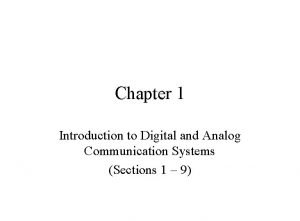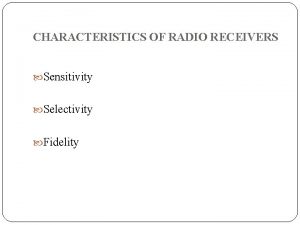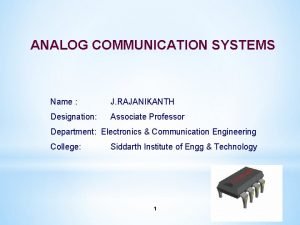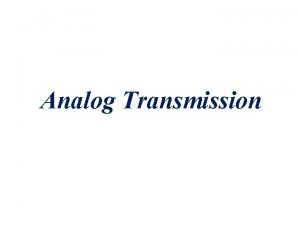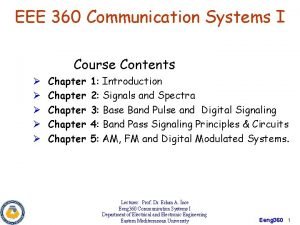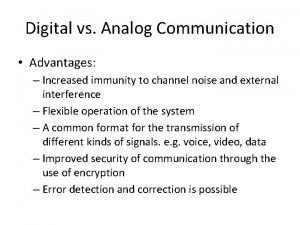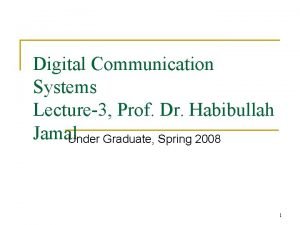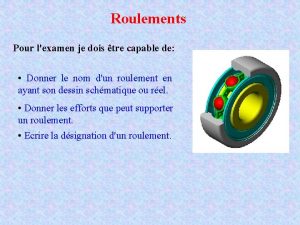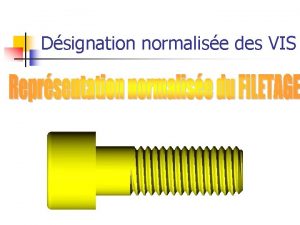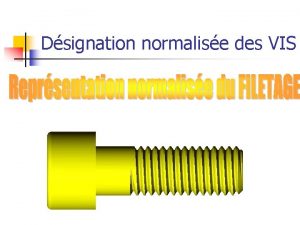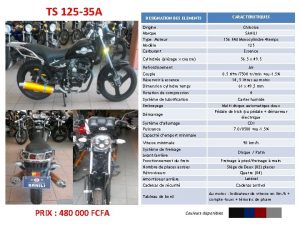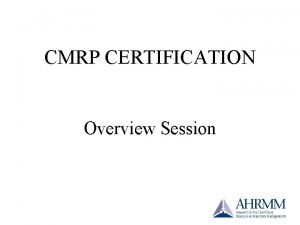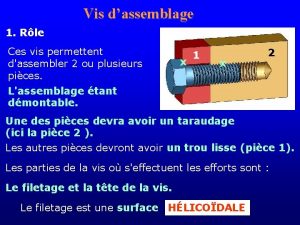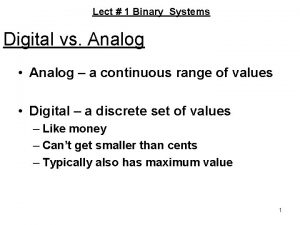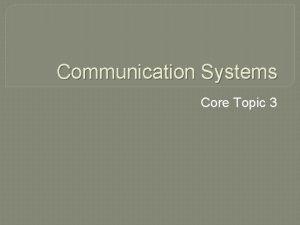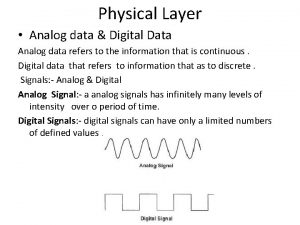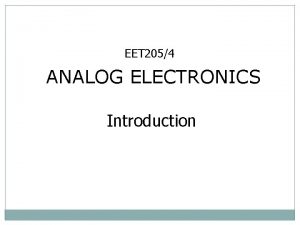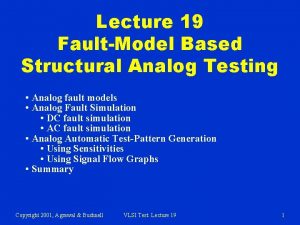ANALOG COMMUNICATION SYSTEMS Name J RAJANIKANTH Designation Associate













































- Slides: 45

ANALOG COMMUNICATION SYSTEMS Name : J. RAJANIKANTH Designation: Associate Professor Department: Electronics & Communication Engineering College: Siddarth Institute of Engg & Technology 1

ANALOG COMMUNICATION SYSTEMS 2 Wednesday, February 24, 2021

* ANALOG COMMUNICATION SYSTEMS 3 Wednesday, February 24, 2021

ANALOG COMMUNICATION SYSTEMS 4 Wednesday, February 24, 2021

ANALOG COMMUNICATION SYSTEMS 5 Wednesday, February 24, 2021

ANALOG COMMUNICATION SYSTEMS 6 Wednesday, February 24, 2021

* ANALOG COMMUNICATION SYSTEMS 7 Wednesday, February 24, 2021

ANALOG COMMUNICATION SYSTEMS 8 Wednesday, February 24, 2021

ANALOG COMMUNICATION SYSTEMS 9 Wednesday, February 24, 2021

ANALOG COMMUNICATION SYSTEMS 10 Wednesday, February 24, 2021

ANALOG COMMUNICATION SYSTEMS 11 Wednesday, February 24, 2021

ANALOG COMMUNICATION SYSTEMS 12 Wednesday, February 24, 2021

Course Objective: • To study the fundamental concept of the analog communication systems. • To analyze various analog modulation and demodulation techniques. • To know the working of various transmitters and receivers. • To understand the influence of noise on the performance of analog communication systems, and to acquire the knowledge about information and capacity. Learning Outcome: • Acquire knowledge on the basic concepts of Analog Communication Systems. Analyze the analog modulated and demodulated systems. Verify the effect of noise on the performance of communication • • systems. • Know the fundamental concepts of information and capacity. ANALOG COMMUNICATION SYSTEMS 13 Wednesday, February 24, 2021

Course Name: Analog Communication Systems (C 226) Year of Study: 2016 – 17 C 226. 1 Able to generate amplitude modulation systems in both the time and frequency domains. C 226. 2 Able to generate angle modulation systems in both the time and frequency domains C 226. 3 Analyze the effect of noise on the performance of communication systems. C 226. 4 Acquired knowledge about pulse modulation systems. C 226. 5 Know the fundamental concepts of information and channel capacity. C 226. 6 Able to distinguish different modulation techniques and their applications ANALOG COMMUNICATION SYSTEMS 14 Wednesday, February 24, 2021

ALL THE POWERS IS WITHIN U, YOU CAN DO ANYTHING AND EVERY THING ----SWAMI VIVEKANANDA *



v. COMMUNICATION SYSTEMS Digital Analog � The block diagram on the top shows the blocks common to all communication systems ANALOG COMMUNICATION SYSTEMS 18 Wednesday, February 24, 2021

Remember the components of a communications system: n n n Input transducer: The device that converts a physical signal from source to an electrical, mechanical or electromagnetic signal more suitable for communicating Transmitter: The device that sends the transduced signal Transmission channel: The physical medium on which the signal is carried Receiver: The device that recovers the transmitted signal from the channel Output transducer: The device that converts the received signal back into a useful quantity ANALOG COMMUNICATION SYSTEMS 19 Wednesday, February 24, 2021

v. ANALOG MODULATION � � The purpose of a communication system is to transmit information signals (baseband signals) through a communication channel The term baseband is used to designate the band of frequencies representing the original signal as delivered by the input transducer � For example, the voice signal from a microphone is a baseband signal, and contains frequencies in the range of 0 -3000 Hz � The “hello” wave is a baseband signal: ANALOG COMMUNICATION SYSTEMS 20 Wednesday, February 24, 2021

� � Since this baseband signal must be transmitted through a communication channel such as air using electromagnetic waves, an appropriate procedure is needed to shift the range of baseband frequencies to other frequency ranges suitable for transmission, and a corresponding shift back to the original frequency range after reception. This is called the process of modulation and demodulation Remember the radio spectrum: AM radio � � FM radio/TV For example, an AM radio system transmits electromagnetic waves with frequencies of around a few hundred k. Hz (MF band) The FM radio system must operate with frequencies in the range of 88108 MHz (VHF band) ANALOG COMMUNICATION SYSTEMS 21 Wednesday, February 24, 2021

� � � � Since the baseband signal contains frequencies in the audio frequency range (3 k. Hz), some form of frequency-band shifting must be employed for the radio system to operate satisfactorily This process is accomplished by a device called a modulator The transmitter block in any communications system contains the modulator device The receiver block in any communications system contains the demodulator device The modulator modulates a carrier wave (the electromagnetic wave) which has a frequency that is selected from an appropriate band in the radio spectrum � For example, the frequency of a carrier wave for FM can be chosen from the VHF band of the radio spectrum � For AM, the frequency of the carrier wave may be chosen to be around a few hundred k. Hz (from the MF band of the radio spectrum) The demodulator extracts the original baseband signal from the received modulated signal To Summarize: Modulation is the process of impressing a low-frequency information signal (baseband signal )onto a higher frequency carrier signal Modulation is done to bring information signals up to the Radio Frequency (or higher) signal ANALOG COMMUNICATION SYSTEMS 22 Wednesday, February 24, 2021

BASIC ANALOG COMMUNICATIONS SYSTEM Baseband signal (electrical signal) Transmitter Input transducer EM waves (modulated signal) Transmission Channel Modulator EM waves (modulated signal) Carrier Baseband signal (electrical signal) Output transducer ANALOG COMMUNICATION SYSTEMS Receiver Demodulator 23 Wednesday, February 24, 2021

Types of Analog Modulation n Amplitude Modulation (AM) n Amplitude modulation is the process of varying the amplitude of a carrier wave in proportion to the amplitude of a baseband signal. The frequency of the carrier remains constant Frequency Modulation (FM) n Frequency modulation is the process of varying the frequency of a carrier wave in proportion to the amplitude of a baseband signal. The amplitude of the carrier remains constant Phase Modulation (PM) n Another form of analog modulation technique which we will not discuss ANALOG COMMUNICATION SYSTEMS 24 Wednesday, February 24, 2021

ABOUT MODULATION � Application Examples � broadcasting of both audio and video signals. � Mobile radio communications, such as cell phone. • Basic Modulation Types – Amplitude Modulation: changes the amplitude. – Frequency Modulation: changes the frequency. – Phase Modulation: changes the phase. ANALOG COMMUNICATION SYSTEMS Wednesday, February 24, 2021 25

Amplitude Modulation Carrier wave Baseband signal Modulated wave ANALOG COMMUNICATION SYSTEMS 26 Amplitude varying. Wednesday, February 24, 2021 frequency constant

Frequency Modulation Carrier wave Baseband signal Large amplitude: high frequency Small amplitude: low frequency Modulated wave Frequency varyingamplitude constant ANALOG COMMUNICATION SYSTEMS 27 Wednesday, February 24, 2021

AM VS. FM � � � � AM requires a simple circuit, and is very easy to generate. It is simple to tune, and is used in almost all short wave broadcasting. The area of coverage of AM is greater than FM (longer wavelengths (lower frequencies) are utilized-remember property of HF waves? ) However, it is quite inefficient, and is susceptible to static and other forms of electrical noise. The main advantage of FM is its audio quality and immunity to noise. Most forms of static and electrical noise are naturally AM, and an FM receiver will not respond to AM signals. The audio quality of a FM signal increases as the frequency deviation increases (deviation from the center frequency), which is why FM broadcast stations use such large deviation. The main disadvantage of FM is the larger bandwidth it requires ANALOG COMMUNICATION SYSTEMS 28 Wednesday, February 24, 2021

AMPLITUDE MODULATION � Several different ways of amplitude modulating the carrier signal by m(t) : l (a) conventional double-sideband AM, l (b) double sideband suppressed-carrier AM, l (c) single-sideband AM, l (d) vestigial-sideband AM. each way results in different spectral characteristics for the transmitted signal. ANALOG COMMUNICATION SYSTEMS 29 Wednesday, February 24, 2021

CONVENTIONAL AMPLITUDE MODULATION AM modulation model A conventional AM signal in the time domain � ANALOG COMMUNICATION SYSTEMS 30 Wednesday, February 24, 2021

CONVENTIONAL AMPLITUDE MODULATION AM modulation model A conventional AM signal in the time domain � ANALOG COMMUNICATION SYSTEMS 31 Wednesday, February 24, 2021

CONVENTIONAL AMPLITUDE MODULATION ANALOG COMMUNICATION SYSTEMS 32 Wednesday, February 24, 2021

CONVENTIONAL AMPLITUDE MODULATION ANALOG COMMUNICATION SYSTEMS 33 Wednesday, February 24, 2021

EXAMPLE 5. 1. 1 � Modulating signal m(t) is a sinusoid : Determine the AM signal, its upper and lower sidebands, and its spectrum. � Solution:the AM signal is expressed as l modulation index: ANALOG COMMUNICATION SYSTEMS 34 Wednesday, February 24, 2021

so that The lower sideband component is: The upper sideband component is : ANALOG COMMUNICATION SYSTEMS 35 Wednesday, February 24, 2021

� The spectrum of the AM signal The power of carrier component is Ac 2 / 2 The power of two sideband is Ac 2 β/ 4 ANALOG COMMUNICATION SYSTEMS 36 Wednesday, February 24, 2021

CONVENTIONAL AMPLITUDE MODULATION � Since the envelope is slowly varying, the positive and the negative halves of each cycle have almost the same amplitude. integral of is almost zero. ANALOG COMMUNICATION SYSTEMS 37 Wednesday, February 24, 2021

CONVENTIONAL AMPLITUDE MODULATION n n � So Note that the second component is much smaller than the first component ( ). This shows that the conventional AM systems are far less power efficient than the DSB-SC systems described in next subsection. ANALOG COMMUNICATION SYSTEMS 38 Wednesday, February 24, 2021

CONVENTIONAL AMPLITUDE rectify the. AM Signals MODULATION Conventional � Demodulation of received signal lowpass filter DC component output of the envelope detector ANALOG COMMUNICATION SYSTEMS 39 gain factor due to the signal demodulator Wednesday, February 24, 2021

ANALOG COMMUNICATION SYSTEMS 40 Wednesday, February 24, 2021

ANALOG COMMUNICATION SYSTEMS 41 Wednesday, February 24, 2021

* ANALOG COMMUNICATION SYSTEMS 42 Wednesday, February 24, 2021

DOUBLE-SIDEBAND SUPPRESSED-CARRIER AM � DSB-SC AM signal is obtained by ANALOG COMMUNICATION SYSTEMS 43 Wednesday, February 24, 2021

DOUBLE-SIDEBAND SUPPRESSED-CARRIER AM n. Spectrum of the DSB-SC AM Signal. n. The bandwidth occupancy of the amplitude-modulated signal is 2 W nthe channel bandwidth required Bc=2 W. n And it does not contain a carrier component ANALOG COMMUNICATION SYSTEMS 44 For this reason, u(t) is called a suppressed-carrier signal. Wednesday, February 24, 2021

DOUBLE-SIDEBAND SUPPRESSED-CARRIER AM ANALOG COMMUNICATION SYSTEMS 45 Wednesday, February 24, 2021
 Analog vs digital communication systems
Analog vs digital communication systems Certified system engineering professional
Certified system engineering professional Experience assessment cipd
Experience assessment cipd Name something you associate with superman
Name something you associate with superman Introduction to analog and digital control systems
Introduction to analog and digital control systems Introduction to analog and digital control systems
Introduction to analog and digital control systems Selectivity sensitivity and fidelity
Selectivity sensitivity and fidelity Thermal noise in analog communication
Thermal noise in analog communication Analog communication system
Analog communication system Digital to analog conversion in data communication
Digital to analog conversion in data communication Block diagram of analog communication system
Block diagram of analog communication system Eee 360
Eee 360 Limiter audio
Limiter audio Analog communication
Analog communication Name all the lines name all the segments name all the rays
Name all the lines name all the segments name all the rays Designation des roulements
Designation des roulements Disbursing officer duties and responsibilities
Disbursing officer duties and responsibilities Vis designation normalisee
Vis designation normalisee 25 cr mo 4 désignation
25 cr mo 4 désignation Désignation des écrous
Désignation des écrous Galvanic element
Galvanic element Smaw electrode designation
Smaw electrode designation Cem designation
Cem designation Canadian registered safety professional designation
Canadian registered safety professional designation Professor designation
Professor designation Désignation normalisée des vis
Désignation normalisée des vis Cignaforhcp
Cignaforhcp Moto sanili ts 125-6
Moto sanili ts 125-6 Cid course descriptors
Cid course descriptors Lane designation terminology
Lane designation terminology Cmrp designation
Cmrp designation Cmrp designation
Cmrp designation Fdp designation
Fdp designation Lane designation terminology
Lane designation terminology Designation of health care surrogate definition
Designation of health care surrogate definition Designation lecturer
Designation lecturer Designation of lecturer
Designation of lecturer Rwa designation
Rwa designation Sgs mdr designation
Sgs mdr designation Sgs mdr designation
Sgs mdr designation Post/designation
Post/designation Press brake two hand control
Press brake two hand control Vis fhc signification
Vis fhc signification Designation agreement pst
Designation agreement pst Chrl designation
Chrl designation Cmrp certification
Cmrp certification
